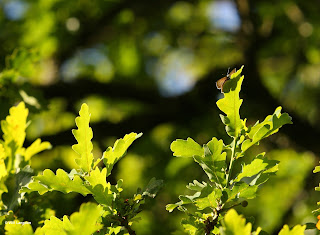One of the things that characterises the common or garden
naturalist, is their obsession with what seems, on the face of it, trivial,
small details that separate species or make them unique and interesting, it’s
these details which give them a richer understanding of the natural world
around them, and give its study its enormous depth and interest.
I am no different, and I’m particularly delighted by
butterflies and moths, and their ecology and life cycles, but also, with that
classic naturalist’s love of the trivial, their scientific names, having done a
bit of Latin and Greek at school, ostensibly useless, dead subjects, it’s nice
to find a purpose for all those ‘wasted’ hours in the classroom and tease out
the meanings of the mighty binomial system that defines everything living on
earth, combining this with photos is always a winner, and so this post will be
the latest part of my flagging challenge on nature photography. |
| 'The Beautiful eyebrow of the bramble.' |
First up is a favourite spring species, Green Hairstreak (Callophrys rubi), flying on moorland,
downland and light woodland across the UK from April to June, it is, like most
hairstreaks highly territorial and males often engage in vicious dogfights from
favoured perches along tree-lines. Callophrys
means ‘beautiful eyebrow’ (kallos – beautiful, and phrys – eyebrow, spliced
together), and rubi means ‘of the
bramble’, a bit of a misnomer, since Green Hairstreaks are polyphagous and feed
on foodplants from several plant families, not just bramble, but others,
including Gorse, various legumes, and bilberry.
A close relative of the Green Hairstreak is the Purple (Neozephyrus quercus), which tends to be
a bit more elusive, favouring the tops of oak trees during July and August - check the crowns at about 6:00 on warm
evenings, and you should see these silvery butterflies, like the Green
Hairstreak, engaging in frequent territorial dogfights. A loose translation of Neozephyrus quercus is something like
‘young west wind of the oak’, where ‘Neos’ is greek for young or new, Zephyrus
is the Greek god of the West wind, and quercus,
of course, is oak. Interestingly, in Greek Mythology, Zephyrus was married to
Iris (the god of the rainbow), who is commemorated in the Purple Emperor’s
scientific name – Apatura iris,
perhaps this hints at the way the two species share habitats, both having an
affinity for oaks, the Hairstreak as a foodplant, and the Emperor as master
trees where males congregate.
 |
| 'The Young west wind of the oak' (on an oak, of course) |
Another branch of the Lycaenidae is the blues, including the aptly named Small Blue, which, measuring in at just 20mm, is Britain’s smallest butterfly. Its scientific name (Cupido minimus) also picks up on its small stature (Small Blues could be forgiven for feeling downtrodden) with ‘minimus’ the Latin for very small, and cupid the tiny love god of Roman mythology.
Keeping with the small theme, Small Skippers get the label Thymelicus sylvestris, where Thymelicus was a dancer in ancient greek
drama known for a strange, erratic dance, picking up on the Small Skipper’s
bouncing flight style, whilst sylvestris
means ‘inhabiting wild places’ – so we have the skipper of the wildlands!
The Large skipper (Ochlodes
faunus) also receives a wild name tag, with ‘Faunus’ another name for the
god of mysterious wild places – Pan/Bacchus, and ‘Ochlodes’ meaning turbulent, relating to the territorial behaviour
of male Large Skippers, which often sit motionless, with their wings held at 45
degrees before attacking anything that dares to enter their territory, so this gives
us ‘the angry wild thing’ in a rough translation.
Returning to the blues, the Large Blue’s Maculinea arion picks up on its life
cycle (the story of the Greek musician arion
provides a neat allegory for its adoption by ants as a larva – see this post for
more: http://mothsandmusings.blogspot.co.uk/2015/11/challenge-on-nature-photography-part-2.html ) and its colouring, maculinea
means ‘many-spotted’, referring either to its underside, with the black spots
on a silvery field, or its upperside, with the strong black forewing markings
which make it so unique among British butterflies (I haven’t quite decided
which). It’s smaller relative, the Silver-Studded Blue (Plebejus argus) again gets its underside examined, with argus a nod to the many-eyed giant of
Greek mythology, and the spotting on this butterfly’s underwing, and ‘Plebejus’ meaning ‘plebeian’ – it sounds
rather damning now, but it was the name given to ‘the common people’ in ancient
Rome, and suggests that this exquisite heath-dweller is a pretty widespread
species (if only!)
 |
| 'The Angry wild thing' - sticking its tongue out at passers by. |
Superb captures Will.
ReplyDelete[http://shutterbugphlogger.blogspot.ca/]
Thanks Marie - some great pictures on your blog too!
Delete